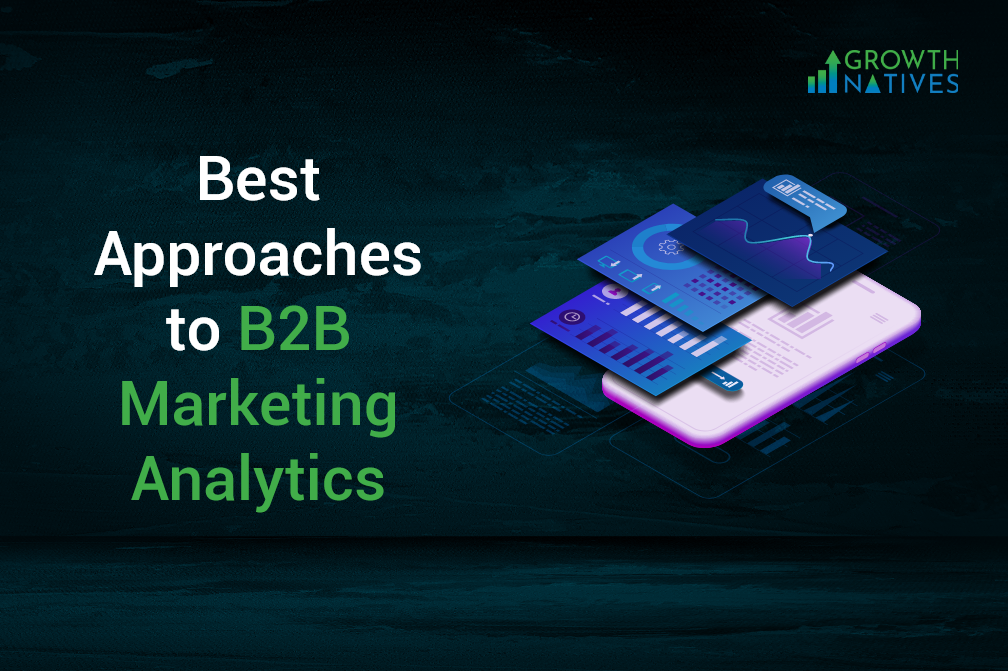Best Approaches to B2B Marketing Analytics

Table of Contents
B2B Marketing Analytics is your trusted sidekick when it comes to getting insights into your business operations and campaign performance. Using B2B analytics, you can gather the important data essential to your ultimate success and nurture keen insights that lay the foundation of a successful business strategy.
Nevertheless, as companies look to make the most out of the many analytical options available to them, they often struggle to choose a strategy that best fits their requirements.

A successful marketing analytics strategy makes the best use of real-time analytics, AI, and automation. As a result, marketing experts today look toward data-driven marketing tools more than ever before.
If you are also wondering how to use data to your best advantage, we have compiled some of the best approaches to B2B marketing analytics that you can use without breaking a sweat.
How to Get the Most Out of B2B Marketing Analytics
1. Analyze Your Lead Sources
Marketers are always curious to know where their leads are coming from; however, not much is done once the information is identified.
With B2B Marketing Analytics, it becomes easier to understand the performance of your lead generation channels and implement changes to improve in real-time.
Pro Tip: Select the Prospects dataset, and then group by using the Source field. You can also add a filter to exclude low-producing sources, and add relevant widgets to enhance your viewing experience.
2. Create Your Own Lifecycle Report
If you’re using marketing automation software like Pardot, you may feel the Pardot Lifecycle doesn’t truly reflect your company’s unique prospect flow.
For instance, Pardot may define Marketing Qualified Lead (MQL) as a prospect who has been assigned and a Sales Qualified Lead (SQL) as a prospect linked to an opportunity, but for you, both these stages could be very different.
With B2B Marketing Analytics, you get the power to create customized lifecycle reports that best suit your marketing style and strategy.
3. Align Your Grades with Revenue
A grading system can be a highly effective tool to outline the perfect buyer profile. With B2B Marketing Analytics, you can evaluate how your grading system is performing and how your graded prospects are distributed across different lifecycle stages.
Pro Tip: To create an effective grading system, combine the Prospect dataset with the Opportunities dataset, use Count of Rows as your measure, and group by Stage and Grade.
You can also use the Sankey visualization to get a more detailed view of your distribution.
4. Identify Most Engaged Prospects
When you are creating a custom grading system, identifying your ideal prospects is the most important factor.
With B2B Marketing Analytics, you can easily identify the key characteristics of your prospects and categorize them accordingly.
Pro Tip: Make sure to use the grouping that is most relevant to your segmentation strategy. You can also add relevant filtering widgets to streamline the process.
5. Recognize Your Top Performing Content
Remember, not all content is created equal. Where some of your content could be converting sales, the rest of it could be causing opt-outs.
Make sure to create a dashboard to overlook your content, and identify the best performing one. Based on it, revamp your content strategy.
Pro Tip: Create additional lenses to get a comprehensive view of all your content assets and gauge performance.
B2B Marketing Best Practices
To ensure the success of B2B analytics, it’s important to measure the amount of value your business receives based on recommendations.
Source: MLT Creative
To make this happen, follow these B2B marketing best practices:
Take Action on Insights
Cultivate a team to work on your marketing analytics and deduce insights that you can work with.
Speed and agility in response to B2B analytics are essential. So make sure you take the help of individuals who best know your business and make the best decisions for your marketing efforts whenever required.
Only Make Recommendations You Can Measure
Taking actions without thinking about how you will measure the results can be a poor strategy. A solid feedback mechanism will let you deduce insights into ROI generation and increased productivity.
Use Multiple Strategies
Choose and implement a plethora of strategies to find appropriate recommendations using prescriptive analytics. Make sure you try out different tools and strategies to find the one that works best for you.
Takeaway
B2B marketing teams are constantly striving to achieve a positive ROI and result for their overall efforts. With real-time analytics, you can get a clear view of the marketing scenario along with the capability to make actionable improvements to your activities.
Connect with us to discover how you can couple marketing automation with B2B analytics to turbo-charge your business operations.
Author Box
Sakshi Arora
Sakshi Arora is a seasoned content writer and editor with extensive experience across various industries including B2C, B2B, travel, e-commerce, and IT. In her free time, she enjoys expressing her creative side through painting and writing poetry. She also finds solace in nature and has a deep spiritual connection. Music brings her immense joy.




